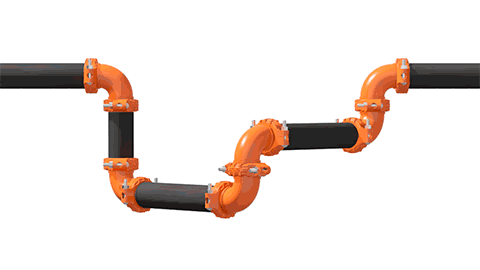According to Marcel Ley, Regional Manager at Victaulic South Africa, some of the most damaging affects to a piping system can be the result of not accommodating for movement. Temperature changes can exert dangerous and damaging reactive forces on pipe components and equipment. There are, however, measures to accommodate pipe movement in instances of thermal change, he says.
These include pipe design flexibility; a reduction in pipe system stress; a more compact and productive method of installation as opposed to welding; and finally the conformity to industry practises. “The key to effectively accommodating thermal expansion and contraction in a piping system is to allow the predictable, controlled movement of the piping itself. This can be achieved in a variety of ways. The selection of a specific method is based upon the engineer, the type of piping system and the project parameters,” Ley explains.

He adds that there are a number of key factors in which grooved coupling can accommodate thermal movement. Firstly, grooved couplings provide an expansion joint by using grooved mechanical pipe components, which essentially allow the system to ‘free-float’. Additionally, they utilise the linear movement or deflection capabilities of flexible grooved couplings, as well as providing an expansion loop by making use of the grooved mechanical components.
“We at Victaulic believe that grooved couplings are a smart alternative to conventional methods. Not only are they easier and faster to install over welding, but they accommodate movement within the design capabilities of the grooved coupling,” Ley says.
“By allowing for thermal movement within the pipe join itself, piping systems can be installed in smaller spaces. The inherent flexibility of the pipe joint ultimately lowers stress on the various components in the system.”
He adds that Victaulic products are tested to accommodate not only thermal, but seismic movement as well. This allows for system durability in practically all conditions.
Ley says that the main approach to designing a piping system that accommodates seismic activity is a combination of rigid couplings and flexible couplings in key areas of the system to accommodate movement and sway. “Typically more than 95% of the grooved couplings used in a piping system will be rigid, while the remainder will be flexible couplings. The importance of this lies in the fact that too much swing could affect other pipes and equipment, despite being within the capability of the grooved coupling. The key to effectively accommodating movement in a building is to allow controlled movement, and that can be done with flexible grooved technology.”
Two basic grooved coupling styles can be found. These are flexible grooved couplings which allow for a restrained amount of angular and axial movement, and rigid grooved couplings, which do not allow for movement and can be used in instances where immobility in the pipe joint is needed. These are similar to a flanged or welded joint.
“Victaulic goes to great lengths to ensure that its products meet the highest industry standards, and have for decades allowed engineers the benefits of simplifying the construction of structures without negating safety and quality standards,” Ley concludes.
Credit: https://www.victaulic.com/accommodating-seismic-movement/






















